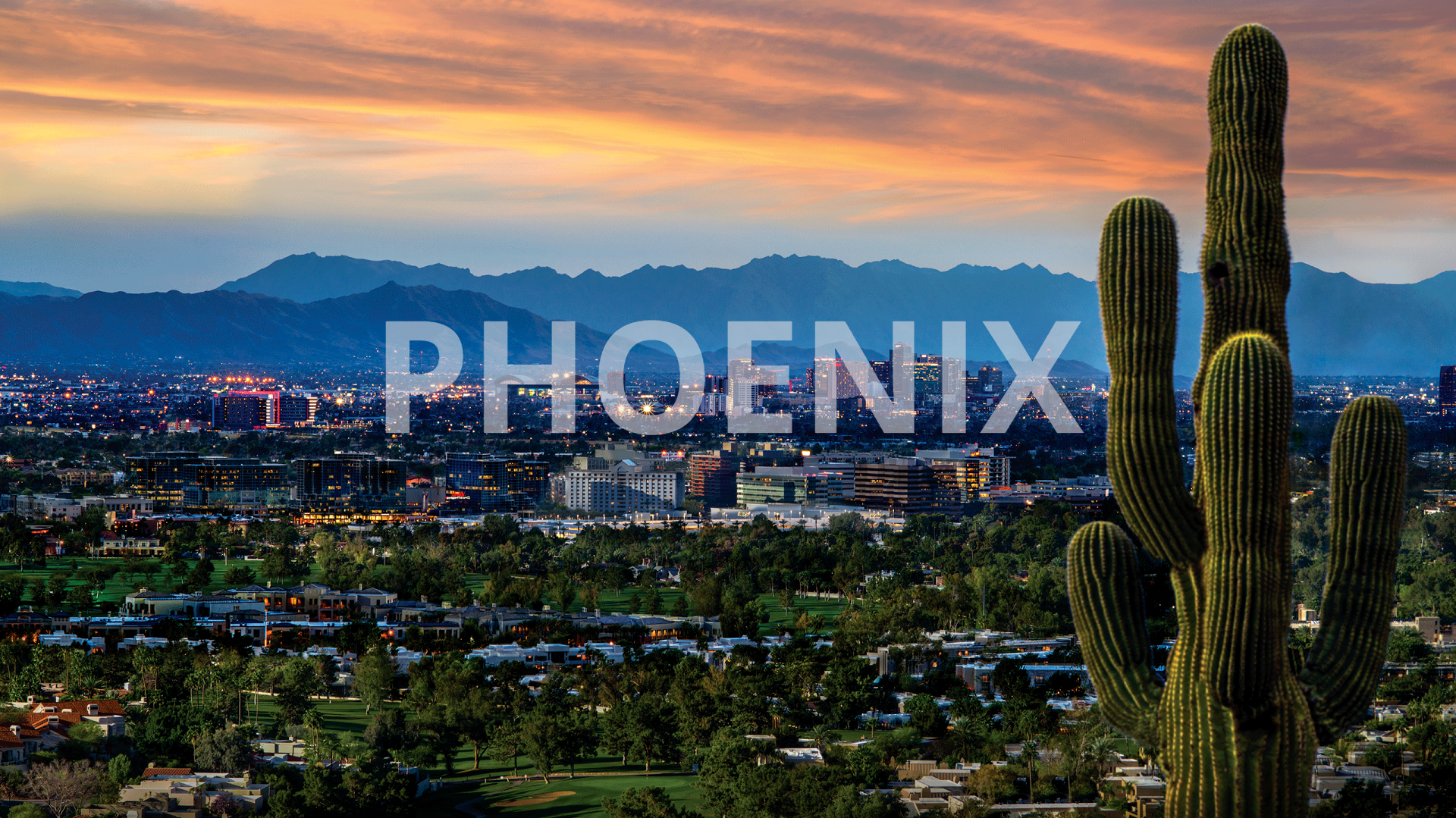Phoenix, AZ
Phoenix, city, seat (1871) of Maricopa county and capital of Arizona, U.S. It lies along the Salt River in the south-central part of the state, about 120 miles (190 km) north of the Mexico border and midway between El Paso, Texas, and Los Angeles, California. The Salt River valley, popularly called the Valley of the Sun, includes not only Phoenix but also nearby cities such as Mesa, Scottsdale, and Tempe. Phoenix plays a prominent role in the economy of the Mountain West region of the country, serving as a financial, communications, and transportation hub. Area 450 square miles (1,165 square km). Pop. (2000) 1,321,045; Phoenix-Mesa-Glendale Metro Area, 3,251,876; (2010) 1,445,632; Phoenix-Mesa-Glendale Metro Area, 4,192,887.
Character of the city
With its broad, tree-lined avenues, Spanish-style architecture, and surrounding mountains, Phoenix bears much resemblance to Los Angeles. Like its California counterpart, Phoenix is a metropolis with not one but many centres, all at considerable distances from one another. From its historic heart to the west of Sky Harbor International Airport, the greater metropolitan area—of which Phoenix is only a small part—has grown to take in a vast expanse of land that stretches nearly from the Gila River far to the south to the tall plateaus and volcanic mountains of the north and east and out into the broad desert valley to the west. Growth is a constant in Phoenix life as thousands of new residents and millions of visitors find their way there each year.
Landscape
City site
Phoenix lies near the confluence of the Gila and Salt rivers and is situated at the extreme northern part of the Sonoran Desert, an arid ecological zone whose characteristic plant is the nationally protected saguaro cactus. To the east of Phoenix are the rugged Superstition Mountains, a large complex of volcanic calderas that formed about 305 million years ago; the mountains reach to about 3,000 feet (900 metres) at their highest point. The Mazatzal Mountains rise to the northeast; the Verde River flows to the west of the mountains, entering the Salt River east of Phoenix.
The broad valley in which the city lies extends west to the Colorado River and south to the mountain chains north of Tucson, although the geographic borders of Phoenix end far short of those natural barriers. The Phoenix metropolitan area—the Valley of the Sun—stands at an elevation of 1,100 feet (335 metres) above sea level. The northern and eastern ends of this valley rise into the surrounding volcanic peaks; the remainder is level terrain, dotted with small volcanic mountains of granite and schist. Camelback Mountain, Squaw Peak, and South Mountain are the most prominent of these urban peaks, reaching elevations of about 2,600 to 2,700 feet (790 to 820 metres).
The desert soil is alkaline, and the water in the river and in local wells is saline and contains other minerals. Many irrigated areas in the Phoenix area are encrusted with dried mineral deposits, which accumulate and reduce the productivity of the soil. Water is strangely abundant, given the fact that the city lies in one of the most arid regions on the continent; the valley overlies a subterranean sedimentary bowl that can hold vast quantities of groundwater. However, these stores have been substantially depleted, and Phoenix increasingly has come to depend on water from the Colorado River via the Central Arizona Project (CAP), an artificial waterway 336 miles (541 km) long extending from Lake Havasu on the California border to Tucson. In addition, water from subterranean stores is piped into the valley from outlying areas. In the past, virtually all of the region’s water was used for agricultural purposes, although an increasing share is now apportioned for municipal use.
People of Phoenix
The population of Phoenix is predominantly white (i.e., generally of European ancestry); the site was settled largely by Midwesterners in several waves of migration. More than two-fifths of the people identify themselves as Hispanic. A large proportion of the city’s Hispanic population is from Mexico, and Hispanics constitute a significant segment of the unskilled labour force. Other minorities in the city are Asians, African Americans, and Pacific Islanders.
The Hohokam were the earliest permanent Native American inhabitants of the Phoenix area. After them came the Akimel O’odham (Pima), Maricopa, Yavapai, and Yaqui groups. The U.S. government sent many of these peoples to nearby reservations in the 19th century. Although only a fraction of the city’s population is Native American, Phoenix still has one of the largest urban concentrations of Native Americans in the country. Several reservations are located to the south and northeast of the metropolitan area.
African Americans, Hispanics, and Native Americans live primarily in the southern portion of the city, below the downtown district. Open ethnic conflict is rare, except as it is played out by rival gangs of mostly young inner-city residents.
Despite the large number of retirement communities in the area, the overwhelming majority of the population is under the age of 45. The majority of the people also tend to be relatively new to the region, many residents having lived in Phoenix for less than a decade
Economy
Phoenix’s economy was once dominated by ranching and farming, but it shifted in the mid-20th century to one based on services, technology, and, more notably, tourism. Maricopa county was one of the top urban agricultural producers in the country in 1980, but farming has since steadily lost ground to urban growth; now only a small portion of the labour force is engaged in food production.
About three-fourths of the state’s manufacturing jobs are located in the Phoenix area. Light industry is predominant, especially the manufacture of electronics, transportation equipment, aerospace technology, foodstuffs, and cosmetics. The principal crops are cotton, durum wheat, fruits, and vegetables. Only a small proportion of the workforce in the private sector belongs to labor unions, which, along with tax incentives, has made Phoenix attractive to relocating corporations, many of them engaged in the manufacture of semiconductors and other electronic components. The region has thus emerged as a center of high-technology production. A well-developed electronics infrastructure also has made Phoenix a capital of the telecommunications industry. More than half the labor force works in banking, finance, and other service activities. For the most part, however, the city’s economy still depends on tourism, especially in the winter months.
Phoenix is well served by roads, railways, and airlines. Automobiles are the most popular method of transportation, which has led to severe air pollution. All streets within the city limits were paved by 1920, far ahead of many metropolitan areas in the country. Phoenix is served by a system of freeways, most of which were built in the last two decades of the 20th century to alleviate congestion. Construction of a light-rail system began in 2006. A branch line of the Union Pacific Railroad connects the city to the main line between Los Angeles and El Paso. Regular airline connections to Phoenix began in the late 1920s. Several airports serve the metropolitan area; the most important of these is Sky Harbor International, southeast of downtown.
History
The early period
Archaeological excavations in the mid-20th century by Emil W. Haury at Ventana Cave, southwest of Phoenix, uncovered human and animal remains and stone tools dating to about 10,000 years ago. Possibly as early as 300 BC, the Hohokam people arrived in the area and remained until about AD 1400. A farming people, the Hohokam developed an elaborate system of irrigation canals extending far from the banks of the Salt River. Hohokam culture collapsed in the 15th century for reasons that are not entirely known. The Akimel O’odham (Pima) were the successors to the Hohokam in the Phoenix area.
European arrivals
Spanish explorers arrived in what is now Arizona in the 16th century. A chain of missions and small forts extending northward from Mexico along the Santa Cruz River valley was established by 1700. In that period the Spanish made contact with the Akimel O’odham and Maricopa Indians, whose settlements along the Salt and Gila rivers were in close proximity to the northernmost mission.
In 1846, following the outbreak of the Mexican American War, a detachment of Mormon volunteers entered the region and made its way to the villages of the Akimel O’odham. There they traded goods for fresh produce and grains. After the war, some of the Mormons returned to the area, established small farms along the Gila and Salt rivers, and founded the towns of Mesa, Florence, and Safford.
The Mormons gave the name Pumpkin Ville to what is now Phoenix. In 1867 Jack Swilling, a Confederate veteran of the American Civil War, began a grain-milling business near the site of the present Sky Harbor International Airport to provision the federal garrison at Camp McDowell. Two years before Swilling’s arrival, a local farmer named John Y.T. Smith, the first person of European descent to settle in the Salt River valley, had planted grain in the area. The renaming of the town was left to an Englishman and early town civic leader, Darrell Duppa. He chose the name Phoenix, giving the explanation, “A new city will spring phoenix-like upon the ruins of a former civilization.”
From a town to a city
Pioneers came to the valley in increasing numbers throughout the late 1860s, and on October 20, 1870, Phoenix was officially established as a town. A county building and the area’s first schoolhouse were completed in September 1872. A telegraph line, operated by the pioneer prospector and merchant Morris Goldwater, was established in 1874, and a national bank opened in 1878.
After Phoenix became a city in 1881, civic leaders began to lobby for the construction of a railroad. In July 1887 a secondary line of the Southern Pacific Railroad (now Union Pacific Railroad) connected Phoenix to the main line leading east to El Paso and west to Los Angeles, providing a large and accessible market for the valley. With increased prosperity, the city began to modernize. Having already opened one of the first electric-power generating plants in the West in 1886, the city installed a streetcar system that soon traversed much of the valley. Within a few years Phoenix also had a hospital, a public library, and other municipal facilities.
Those leaders also worked to bring the Arizona territorial capital to Phoenix. Since the establishment of the territory in 1864, the legislature had relocated from Prescott to Tucson, then back to Prescott again. After extensive lobbying on the part of the city’s emerging business elite, the legislature moved to Phoenix in 1889. A local farmer donated a 10-acre (4-hectare) site for the territorial capitol, and the new building was dedicated on February 25, 1901. When Arizona attained statehood on February 14, 1912, the building became the state capitol.
Source:







